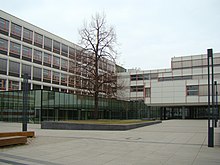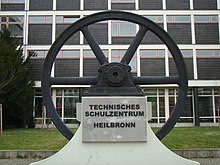Technical school center Heilbronn
The technical school center in Heilbronn , consisting of the Wilhelm-Maybach-Schule and the Johann-Jakob-Widmann-Schule , is one of the most important vocational training centers in Baden-Württemberg , the roots of which go back to the middle of the 19th century. With the similar school in Stuttgart, the Heilbronn commercial advanced training school was one of the first two schools of this type in Württemberg in 1854. For several decades it was the largest vocational school in Württemberg with up to 3800 students. After moving into a new school complex on Heilbronn's Paulinenstrasse, the school was divided into two independent schools in 1956. In 1973 the trade school I was named after Wilhelm Maybach , who was born in Heilbronn , while the trade school II was named after the Heilbronn industrial pioneer Johann Jakob Widmann . Both schools were attended by almost 5300 students in the 2002/2003 school year.
history
Beginnings of the trade schools in Württemberg
From 1739, attending Sunday schools was compulsory in Württemberg . Around 1760, in addition to the religious Sunday schools, the first professionally oriented Sunday schools were established, and around 1780 schools for the poor and industrial schools, which were intensively expanded after 1800. In 1825, a request was made to all larger Württemberg municipalities to set up Sunday trade schools. Attending such a voluntary school exempted from the obligation to attend any other Sunday school from 1836.
In Heilbronn, the first suggestions for the establishment of a trade school came from the teacher and later rector of the Karlsgymnasium , Heinrich Christian Kapff (1794–1844). As early as 1834 he demanded in a memorandum the “establishment of secondary and commercial schools in the provincial towns of Württemberg with special consideration for Heilbronn”. Kapff, however, was still in a lonely position, as his colleagues at the Karlsgymnasium were skeptical of his ideas. The Heilbronn factory owner Georg Peter Bruckmann donated the impressive sum of 10,000 guilders for a drawing and modeling class at a Sunday trade school that was already in existence at the time. In 1846 he set up his own drawing and modeling school, in which he particularly wanted to train talented youngsters for the Peter Bruckmann & Söhne silverware factory .
After a recommendation had been issued in 1853 to convert the Sunday trade schools into commercial advanced training schools, the first such schools were established in Heilbronn and Stuttgart in 1854 , mainly at the instigation of Ferdinand von Steinbeis , and the number of these schools increased to 55 by the following year. The Bruckmann school of drawing merged into the Heilbronn commercial advanced training school, which was housed in four different city buildings, mainly in the area of the former Franciscan monastery on the port market. There were also other Heilbronn schools there, so that the lack of space led to the decision to build a new building for the Realanstalt and trade school as early as 1871.
Own premises in Jägerstrasse
The start of construction and the construction time of the new building dragged on, so that the Heilbronner Gewerbeschule only received its own specialist rooms and workshops in the Heilbronn Realanstalt (today: Robert-Mayer-Gymnasium ) in Jägerstraße (today: Bismarckstraße) in 1889 . The trade school occupied the wing of the building, which was extremely modern for the time, on the right from Jägerstraße. It extended over three floors and had several drawing rooms and technical rooms. In 1899 the technical and commercial schools were separated. In 1906 the city of Heilbronn introduced compulsory day school for apprentices and workers under the age of 18 three years before the legal obligation.
In 1937 the trade schools were renamed vocational schools . At that time, the Heilbronn vocational school also experienced an upswing through the establishment of a master’s school with boarding school. In Württemberg, apart from Heilbronn, there was another such facility in Ulm. With over 2000 students, the commercial vocational school was the largest of its kind in Württemberg.
The Second World War severely hampered the operation of the vocational school from 1942 onwards, as pupils and teachers were either drafted into military service or engaged in harvest aid or arms production. In addition, most of the Heilbronn school buildings were destroyed in the air raid on Heilbronn on December 4, 1944.
In temporary accommodation, etc. a. in the Wolko shoe factory , vocational school began again in February 1946 for 1,600 pupils in 62 classes. In 1947 the Kaiser Otto in Happelstrasse, formerly a farm building of the food manufacturers Otto & Kaiser, then owned by the food manufacturer Knorr from 1932 , was converted into a school building for the trade school. In 1949 around 3300 vocational students were taught in various accommodations in Heilbronn, in addition to the aforementioned buildings and the like. a. also in the Heilbronn youth hostel , in the former Böckingen women's labor school and in the city theater .
Construction of the trade school on Paulinenstrasse
In 1951 an architectural competition was held to build a new trade school on the former site of the municipal hospital in Heilbronn's Paulinenstrasse, which was destroyed in World War II. The Heilbronn architect Rudolf Gabel , who was also involved in the reconstruction of Heilbronn in other ways, took first place. In 1952, the local council decided to carry out the design by architects Rudolf Baer (Heilbronn), Siegfried Hieber and Rudibert Pfund (Bad Cannstatt), which came third . The architectural community also took over the construction management. The new building costing DM 6.7 million was started in January 1953 and in 1955. It was considered the largest and most modern commercial school in Baden-Württemberg. Part of the construction costs were also earmarked for art in architecture . Wall decorations were provided by Peter Jakob Schober from Billensbach, Hans Epple from Flein, Hannelore Busse from Jagstfeld, Margot Frank from Stuttgart and Paul Wanner from Aalen. The fountain in the school yard was made by Fritz Melis . All that remained of the former hospital was the boiler house on Pestalozzistraße, the facade of which is still recognizable by a historical relief, despite later renovations.
The school was divided into the fields of metal and electrical professions, non-metal and construction professions.
Division into two trade schools
In 1956 the school with 3800 students was still the largest trade school in Württemberg and was divided into two independent schools:
- Commercial vocational school I and technical school: construction, metal, construction metal, electronics, wood, painter
- Industrial vocational school II: health service, personal hygiene, food, paper and printing, textiles and leather, other apprenticeships
In 1958 the two commercial schools were reorganized, with the metal professions as well as one-year electrical and construction metal professions remaining in the technical college I, while all other professions were added to the commercial school II. Until the late 1960s, day technician courses, vocational training school, a one-year vocational school for radio and television technicians, metal technology and electrical engineering, a two-year vocational school and technical high school were added.
By 1961, the low birth rate of the last years of the war made itself felt, so that the school was attended by fewer than 3000 students that year. Subsequently, the number of pupils rose sharply because of the baby boom cohorts that followed and the population growth. In 1962, 3681 pupils attended the school, plus 400 other visitors to the master school and other special facilities. As the number of pupils continued to rise, there was a great shortage of space at the two commercial schools around 1970, so that various temporary accommodation (some of which existed until 1990) in the city area had to be moved into.
In 1973 the commercial schools were given new names: The commercial school I became the Wilhelm Maybach school, named after the Heilbronn-born designer Wilhelm Maybach , while the commercial school II was named Johann Jakob Widmann school after the Heilbronn industrial pioneer Johann Jakob Widmann received. At around the same time, the Heilbronn municipal council decided to expand the building on Paulinenstrasse in two construction phases, which were completed in 1977 and 1979. In the meantime, a technical college for electrical engineering and an academy for operational management for automotive technology had been added to the school. In 1983, the school buildings were extended in a third construction phase, mainly through the conversion of the boiler house, to include additional workshops, then the parts of the building that had already been occupied in 1955 and which had since been renovated were renovated. In total, the expansion and modernization costs amounted to around DM 125 million.
Since 1980, the school's profile has been supplemented by a one-year vocational college to acquire the technical college entrance qualification, a vocational preparation year, a three-year part-time vocational college specializing in automotive technology, and design and media technology and information technology at the technical high school.
In 2002/2003, the Wilhelm Maybach School had 2,670 students (1,680 of them part-time and 960 full-time), while the Johann Jakob Widmann School, which is located in the same building complex, had 2601 students.
In 2011/2012, the technical high school with the profile environmental technology was introduced at the Johann Jakob Widmann School.
Landmark
The landmark of the technical school center is a historic flywheel from 1917, which comes from a gas compressor driven by a piston steam engine . The flywheel donated by the Heilbronn plant of the Kali Chemie company was set up in September 1983 in front of the building along Paulinenstrasse.
Individual evidence
- ^ Report on urban building projects , City of Heilbronn, Stadtbauamt, Heilbronn 1963, pp. 18/19
literature
- Wilhelm Maybach School Heilbronn. Historical development mosaic. Wilhelm Maybach School, Heilbronn 2004
Web links
- Website of the Johann Jakob Widmann School Heilbronn
- Website of the Wilhelm Maybach School Heilbronn
- Entry on the Wilhelm Maybach School in the HEUSS database
Coordinates: 49 ° 8 ′ 56 ″ N , 9 ° 13 ′ 23 ″ E



